Can Analytics Be Privacy-Friendly? GA4 vs Matomo vs Fathom Compared
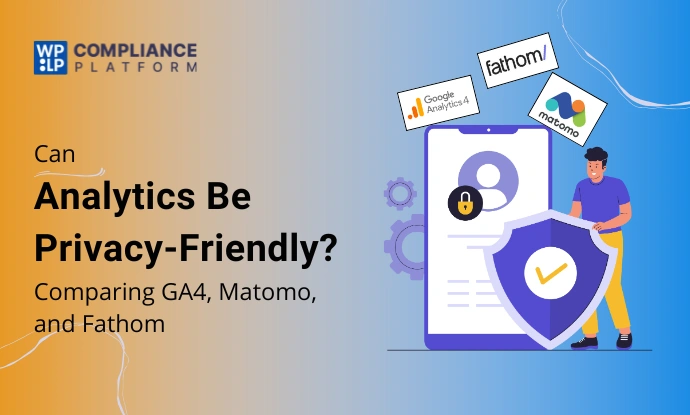
Summary
In this article, we compared GA4, Matomo, and Fathom. We also showed how the WPLP Compliance Platform helps make any analytics setup safer by handling consent, blocking scripts, logging proof, and supporting DSARs.
The internet runs on data. Every time someone visits a website, the website owners want to know what worked, what pages the user saw, how long they stayed, and what made them click. This data helps websites grow and improve their performance.
But here is the problem. Collecting data is no longer simple. New global privacy laws like GDPR, CCPA, and the ePrivacy Directive make it clear that people’s personal information cannot be tracked freely anymore.
This brings us to a big question. Can we analyse user behaviour without breaking privacy rules or losing people’s trust?
Businesses still need analytics, but users want safety and control over their data. The balance is tricky but possible.
In this article, we will explore three major analytics platforms: Google Analytics 4 (GA4), Matomo, and Fathom, to see how privacy-friendly they are.
We will compare their features, assess their compliance status, and also share steps for setting up analytics safely on WordPress. You will also learn how the WPLP Compliance Platform enables analytics that are more privacy-first without compromising insights.
- Privacy Laws and Analytics: Why Compliance Matters
- What Makes an Analytics Platform Privacy-Friendly?
- Platform Overviews: GA4, Matomo, and Fathom
- Privacy Features Comparison Table
- In-Depth Comparison: GA4 Compliance, Matomo vs Fathom Analytics
- Setting Up Analytics for WordPress: Key Compliance Steps
- How WPLP Compliance Platform Enhances Analytics Privacy
- Which one should you choose?
- FAQ
- Conclusion
Privacy Laws and Analytics: Why Compliance Matters
Privacy laws are changing the way websites collect and use data. The GDPR is one of the strongest examples. It advises businesses to follow data minimisation, which means collecting only the data that is necessary and nothing more.
GDPR also says that users must give clear consent before their personal data is tracked. That means no hidden cookies and no silent tracking methods.
Similarly, CCPA and other laws around the world have similar rules. Users must be aware of what is being collected, have the option to opt out, and be able to request that their data be deleted. These rights are now a legal requirement under these privacy laws.
If a business does not follow these rules, the risks are huge. Governments can issue big fines for violations. Companies can lose the trust of their users, making it even more challenging to regain it.
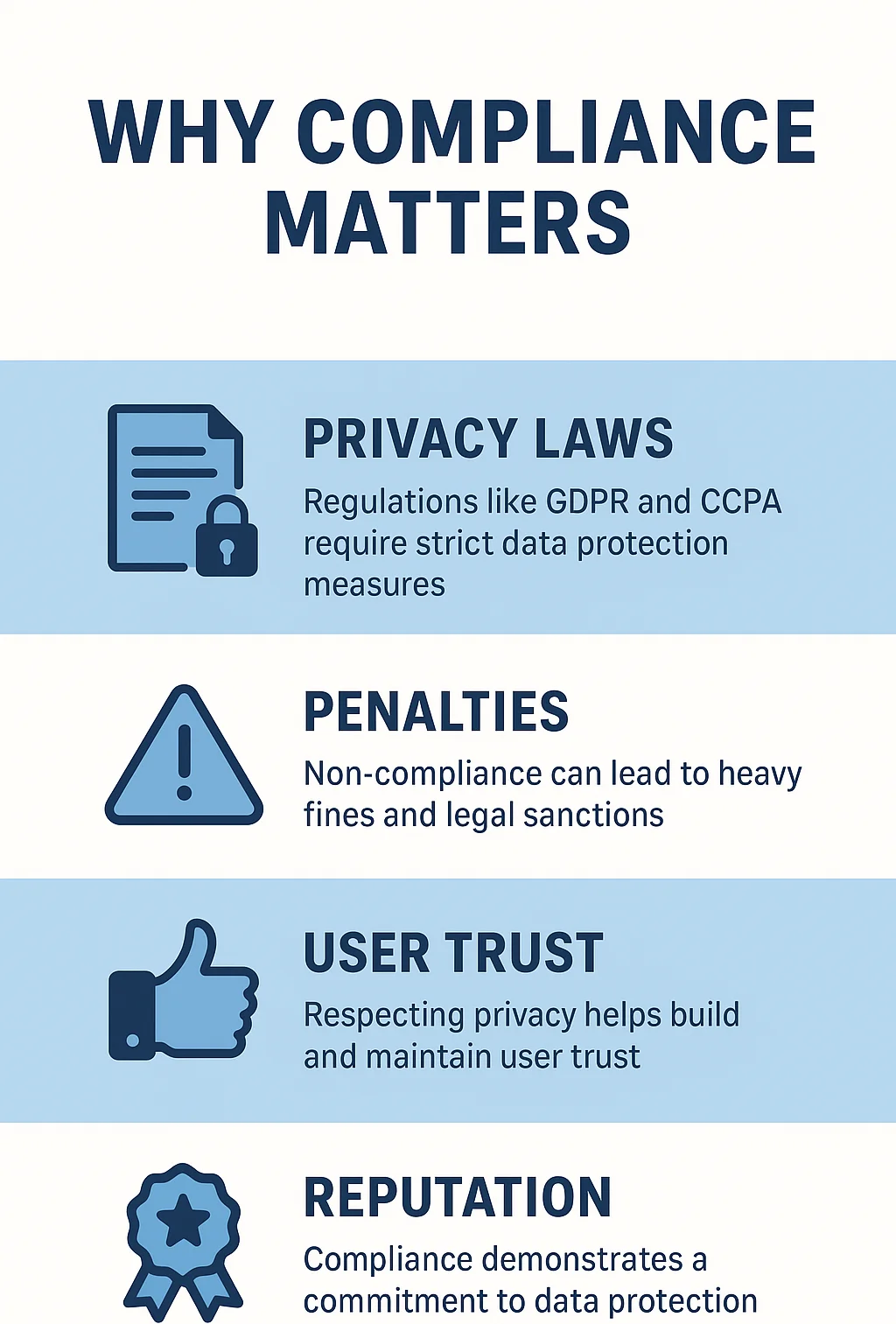
Additionally, users can submit data subject requests, asking for access to or deletion of their information, and businesses must respond promptly. Ignoring these rules can quickly lead to legal and reputation problems.
This is why compliance matters so much for analytics.
What Makes an Analytics Platform Privacy-Friendly?
Not all analytics tools are the same. Some collect every detail about users, while others focus on protecting privacy. A privacy-friendly platform should include a few key things.
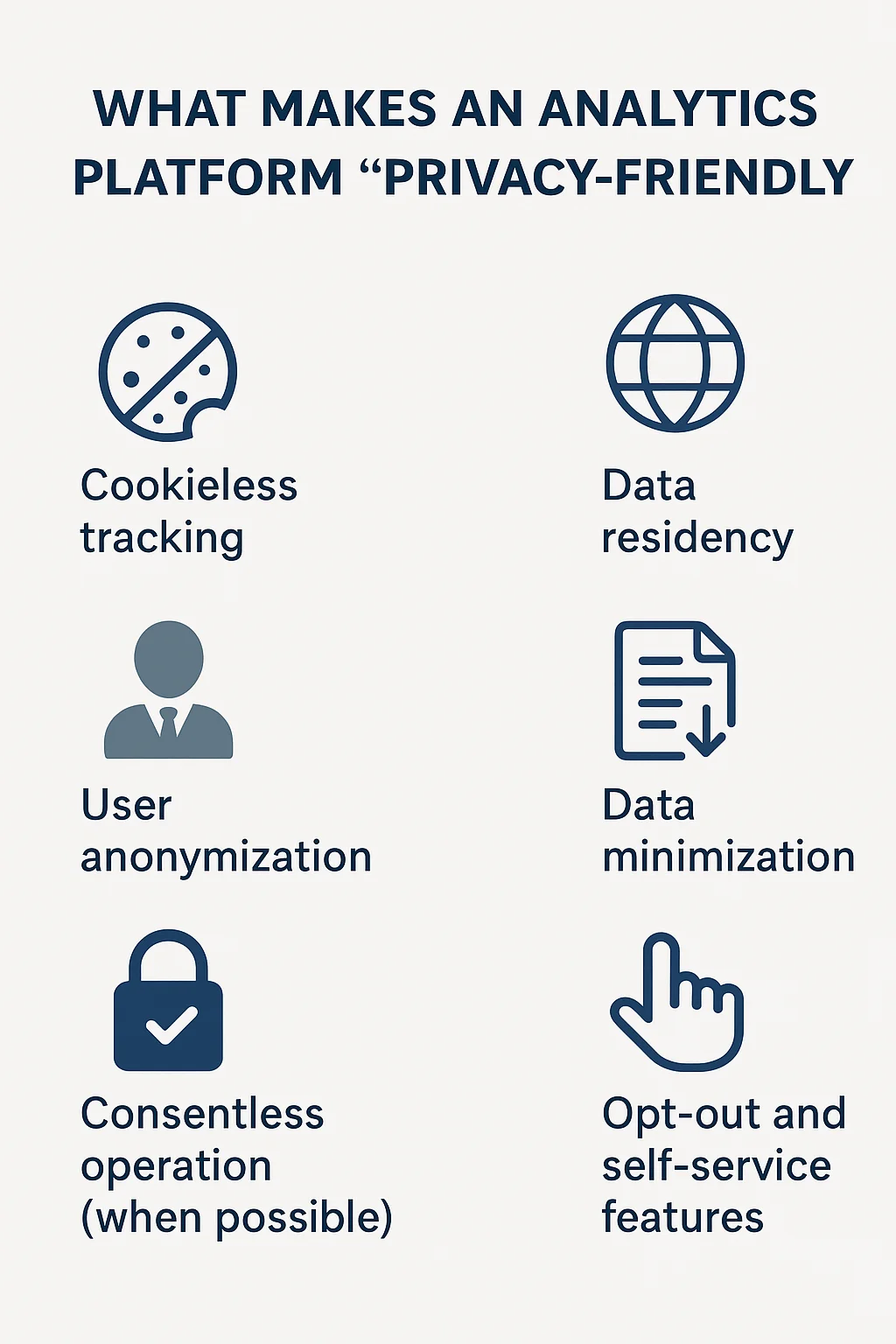
- Cookieless tracking allows websites to gain insights without placing tracking cookies on a user’s device.
- User anonymization, where personal details such as IP addresses are hidden or masked.
- Consentless operation when possible, meaning analytics can still run in a limited, safe way without waiting for user permission.
- Data residency options enable businesses to know exactly where their data is stored and choose regions that comply with local laws.
- Data minimization ensures that only what is necessary is collected, rather than every single piece of information.
- Opt-out and self-service features that enable users to control or delete their data easily.
Many analytics platforms claim to be privacy-friendly. But only a few truly meet the strict requirements of laws like GDPR and CCPA. That is why it is essential to examine closely what each platform offers before making a decision.
Platform Overviews: GA4, Matomo, and Fathom
There are several analytical tools that you can use to analyse your website data, but the most commonly used ones include Google Analytics 4, Matomo, and Fathom Analytics.
Let’s check out each one of these and decide which one suits you best.
Google Analytics 4 (GA4)
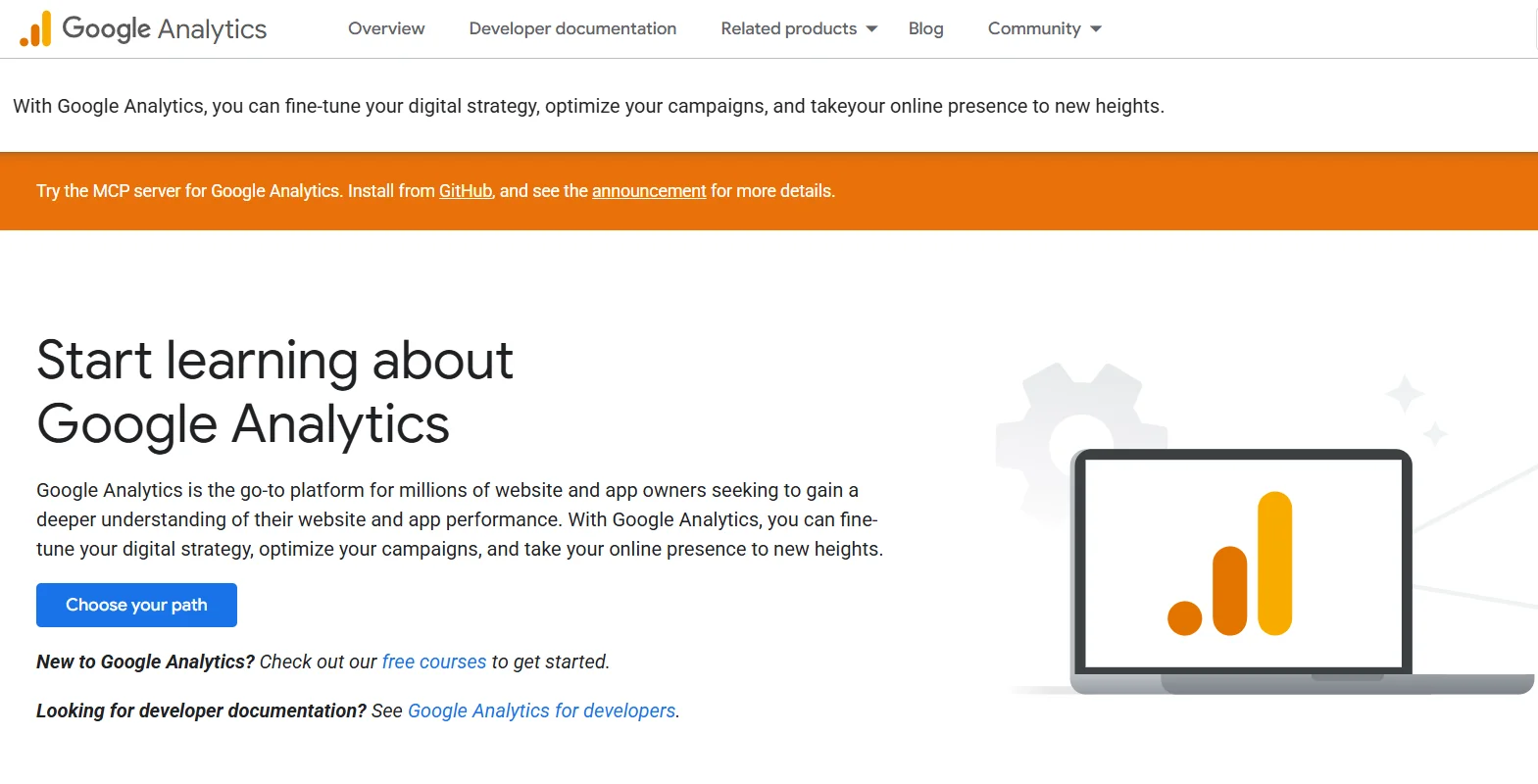
Google Analytics 4 (GA4) is Google’s latest analytics tool, designed for websites and apps. It is cloud-based and widely used by businesses of all sizes because it connects well with Google Ads and other marketing tools.
While it offers features like IP anonymization and data retention controls, GA4 still relies heavily on Google’s servers and cookies, which makes compliance with strict privacy laws more challenging.
Deployment model: Cloud-based, hosted by Google.
Target users: Small businesses, marketers, and enterprises that want deep insights and integration with ads.
Market share: GA4 is by far the most widely used analytics tool in the world. Millions of websites depend on it.
Privacy features: GA4 offers IP anonymization and data retention controls, but it still relies on Google servers and cookies for many features. This makes it harder to use in strict privacy environments.
Matomo
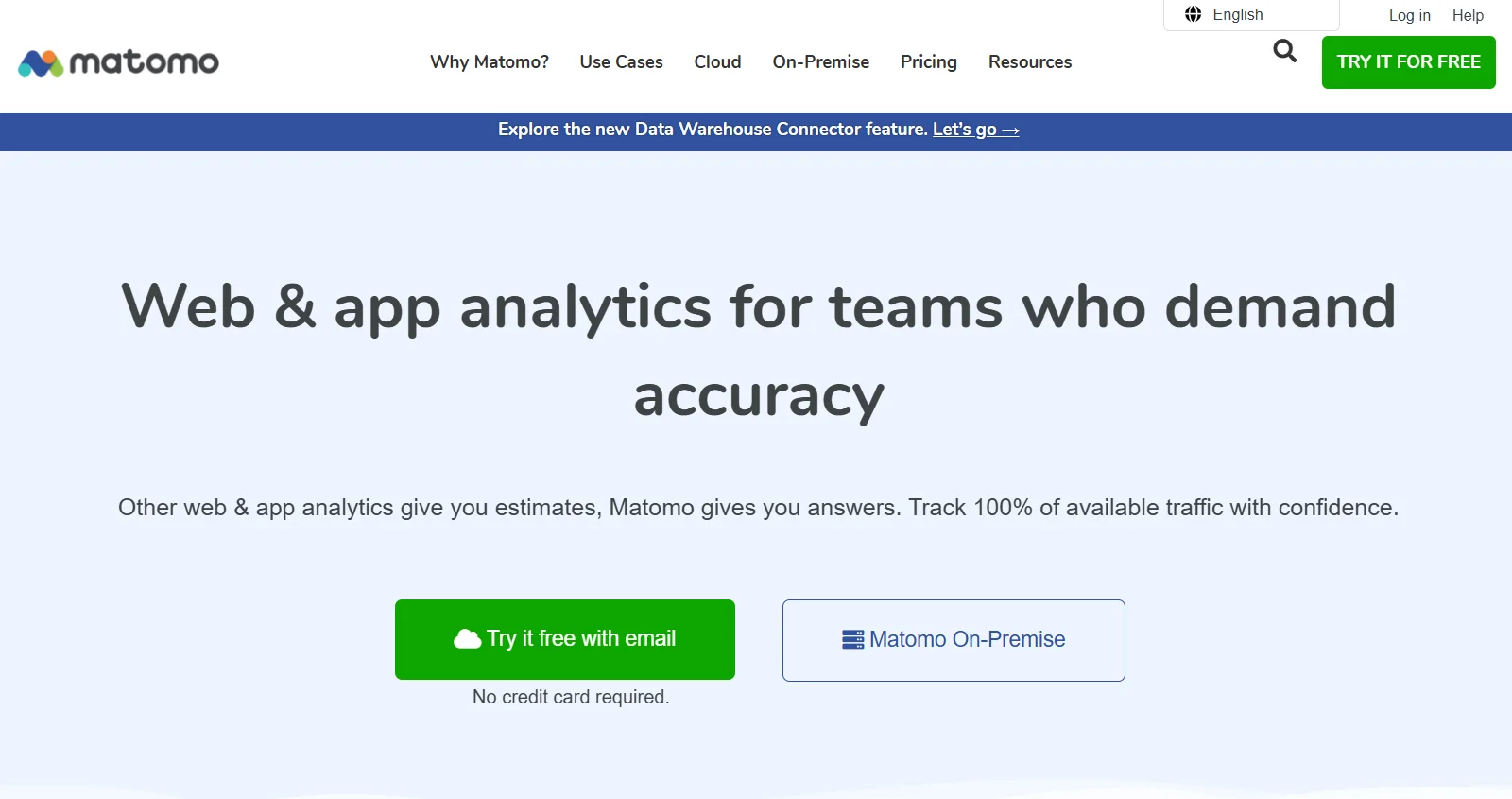
Matomo is an open-source analytics platform that can be hosted on your own server or used through its cloud service. It is trusted by over a million websites, including governments and large organizations, because it gives complete control over data.
Additionally, Matomo has strong privacy features like cookieless tracking, anonymization, and data minimization, making it one of the most flexible tools for meeting GDPR and similar rules.
Deployment model: Available as cloud hosting or self-hosted on your own server.
Target users: Businesses, government sites, and organizations that want full control of their data.
Market share: Matomo is one of the most popular open source analytics tools, with over one million websites using it.
Privacy features: Matomo supports cookieless tracking, IP anonymization, data minimization, and full compliance tools. With self-hosting, the data never leaves your servers, which is a big plus for privacy.
Fathom Analytics
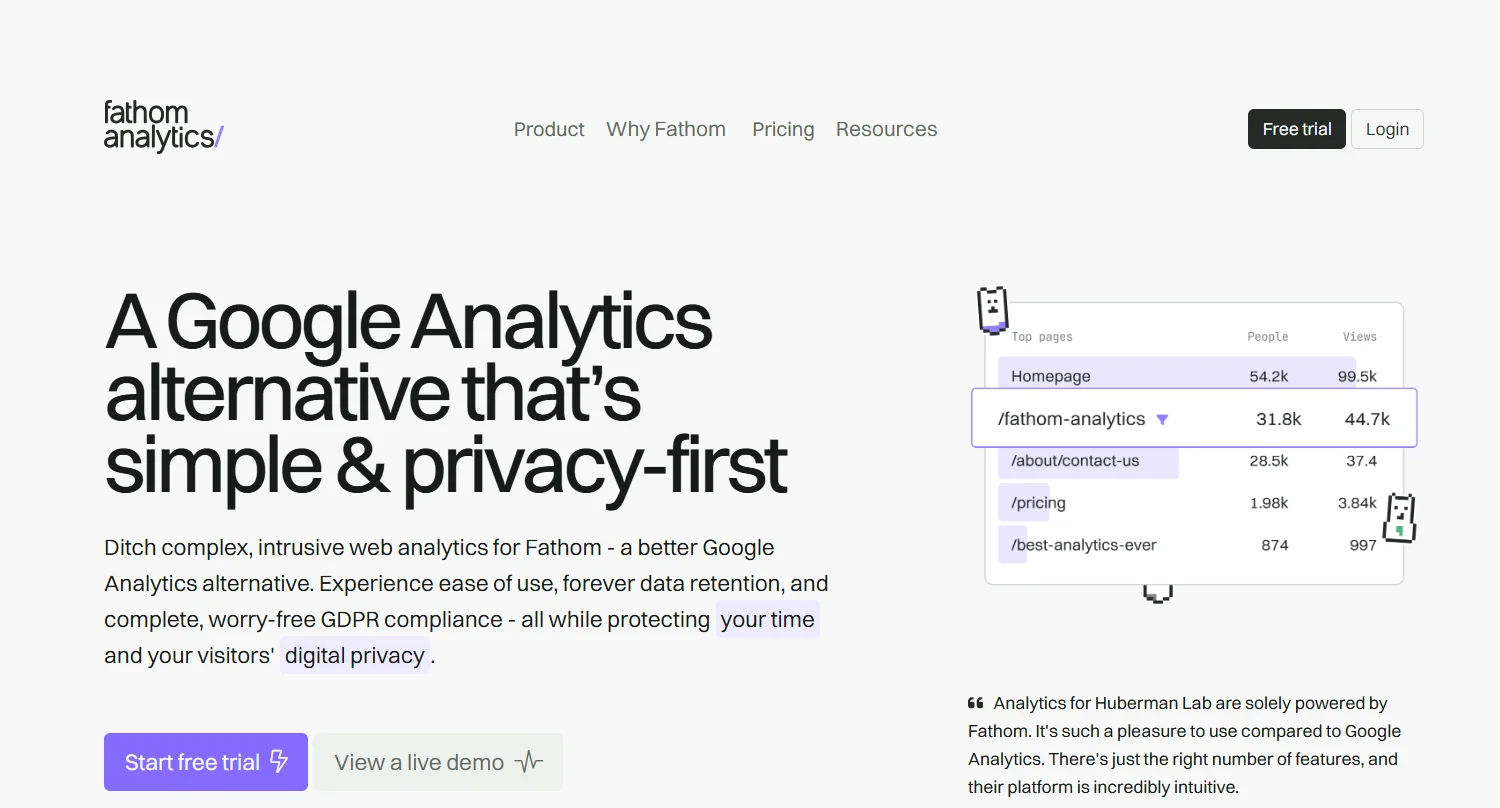
Fathom Analytics is a newer cloud-based tool built with privacy at its core. It is popular among bloggers, startups, and small businesses that want simple analytics without complex dashboards.
Also, Fathom avoids cookies, does not collect personal data, and often does not require cookie consent banners, making it one of the most privacy-friendly and user-friendly analytics platforms.
Deployment model: Cloud-based with servers in privacy-focused regions.
Target users: Bloggers, creators, startups, and small businesses that want simple, privacy-first analytics.
Market share: Fathom is smaller than GA4 or Matomo, but it is growing fast because of its focus on privacy.
Privacy features: Fathom works with cookieless tracking by default, does not collect personal data, and is built to work without asking for cookie consent in most cases. It is one of the simplest analytics tools for staying compliant.
Privacy Features Comparison Table
When evaluating analytics tools, it’s helpful to compare their privacy features side by side. The table below compares GA4, Matomo, and Fathom on key factors like cookieless tracking, data storage, anonymization, and compliance support.
| Privacy Feature | Google Analytics 4 (GA4) | Matomo | Fathom Analytics |
| Cookieless Tracking | Limited (requires setup) | Supported (optional) | Default (no cookies) |
| Consent Mode | Available (Google Consent Mode) | Works with or without consent | Not required in most cases |
| Data Storage Location | Google servers (US/EU) | Choice: self-hosted or EU cloud | Privacy-focused regions (EU/CA) |
| User Anonymization | IP anonymization available | Strong IP and user ID anonymization | Built-in, no personal data stored |
| Data Minimization | Partial (collects by default) | Full control over what is collected | Minimal by design |
| DSAR Support (Data Subject Access Requests) | Manual, limited tools | Built-in export and deletion tools | Not needed (no personal data collected) |
| Integration Ease | Wide ecosystem (ads, CRM, ecommerce) | Plugins for WordPress, WooCommerce, and APIs | Simple setup, lightweight script |
| Market Fit | Marketing-driven businesses, advertisers | Privacy-conscious orgs, governments, enterprises | Small businesses, startups, creators |
In-Depth Comparison: GA4 Compliance, Matomo vs Fathom Analytics
Let’s dive deep into each tool and find out what they have
1. Google Analytics 4 (GA4)
GA4 is packed with advanced features and is the most widely used analytics tool worldwide. It has a consent mode that changes how data is tracked based on user choices, and it supports IP anonymization to hide personal details.
GA4 doesn’t truly offer cookieless tracking; it uses modelling when consent is denied.
The main issue with GA4 is its reliance on Google servers in the US and EU. Under GDPR, sending data outside the EU creates legal risks, and this has already led to fines in some countries. While GA4 gives powerful insights for marketing and ads, it still has compliance gaps that make it a less privacy-first choice.
Privacy regulators in some EU countries (Austria, France, Italy) have already ruled against Google Analytics under GDPR.
Pros: GA4 is free, highly detailed, and integrates with the entire Google ecosystem, including Ads, Search Console, and Tag Manager. It is perfect for marketing-heavy businesses that want granular insights, predictive reports, and cross-device tracking.
Cons: The privacy model is weak compared to other tools, with data often routed through the US. It requires cookie consent in most regions, and the setup can be complex for compliance. For businesses with strict privacy needs, GA4 can be more of a risk than a solution.
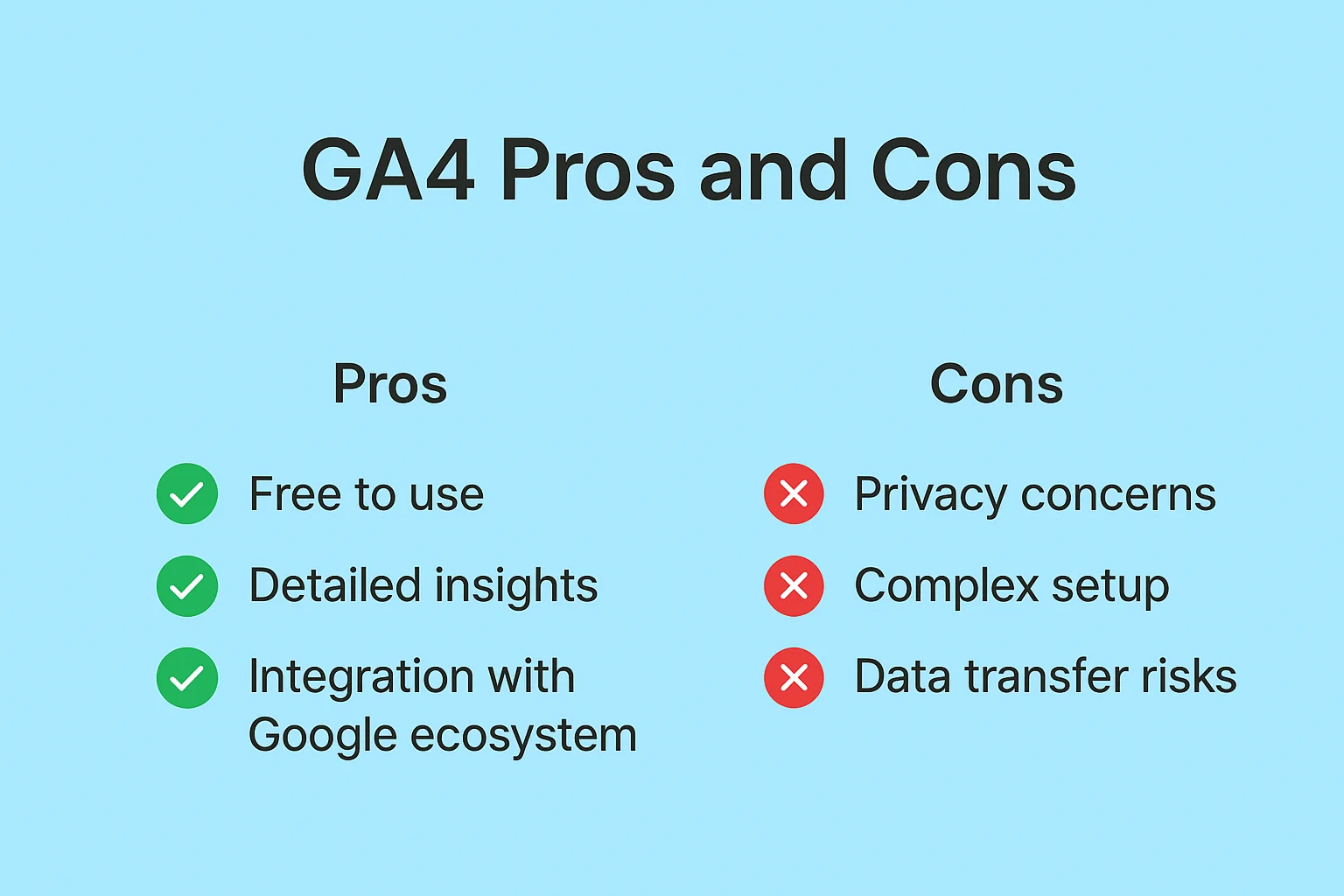
Key compliance cases: GA4 can be used with consent mode to meet GDPR and CCPA rules, but websites must have strong cookie banners and consent management systems in place.
Ideal use cases: Best for ecommerce businesses and advertisers that rely heavily on Google Ads and want advanced tracking.
Common pitfalls: Many businesses think turning on anonymization makes them compliant, but data transfers to Google servers can still create risks under GDPR.
2. Matomo
Matomo gives full control by allowing self-hosting, which means all analytics data can stay on your own servers.
With cloud hosting, Matomo data is stored in the EU, which is still safer than GA4 (though less private than self-hosting).
This is why many governments, universities, and privacy-conscious organizations trust it. There is also a cloud version, but self-hosting gives the strongest compliance benefits because no third party handles your data.
Since Matomo is open source, businesses can customize it for their needs and review the code for transparency. It includes strong privacy tools like cookieless tracking, anonymization, data minimization, and consent banners. For organizations that want deep analytics while still meeting GDPR or CCPA rules, Matomo is often the best choice.
Pros: Matomo offers advanced analytics features similar to GA4 but with far stronger privacy controls. Its self-hosted option is unbeatable for compliance since data never leaves your environment. The platform also has plugins for ecommerce and WordPress, making it flexible for different use cases.
Cons: Matomo can be harder to set up and maintain if you go with self-hosting. The cloud version removes some of the control benefits, and the interface can feel more complex compared to simpler tools like Fathom. It may also require more technical knowledge to unlock its full potential.

Key compliance cases: With self-hosting, Matomo allows businesses to avoid international data transfers, which makes GDPR compliance much easier.
Ideal use cases: Perfect for governments, universities, and organizations that need strict privacy and full ownership of data.
Common pitfalls: Businesses sometimes pick the cloud version and assume it’s fully compliant, but since data is hosted by Matomo servers, it doesn’t offer the same control as self-hosting.
3. Fathom Analytics
Fathom takes a simpler approach by building privacy into the design of the platform. It uses true cookieless tracking, does not collect personally identifiable information (PII), and processes data in privacy-friendly regions like the EU and Canada.
This platform avoids cookies, thereby making it preferable to many websites. It goes hand in hand with compliance tools like the WPLP Compliance Platform.
Moreover, the tool is lightweight and easy to set up, with just a single line of code to add to a site. While it does not offer the detailed reports of GA4 or the customization of Matomo, Fathom focuses on clean, privacy-first analytics.
If you’re running a small business, a startup, or a creator who wants insights that follow GDPR privacy guidelines, then this tool is an ideal choice.
Pros: Fathom is extremely simple, quick to install, and designed for compliance out of the box. With no cookies or PII, it reduces the need for banners, popups, or complex consent flows. The dashboard is clean, and reports are easy for non-technical users to understand.
Cons: The simplicity also means fewer advanced features. There are no deep funnels, predictive analytics, or advertising integrations like in GA4. For organizations that need highly detailed tracking, Fathom may feel limited.
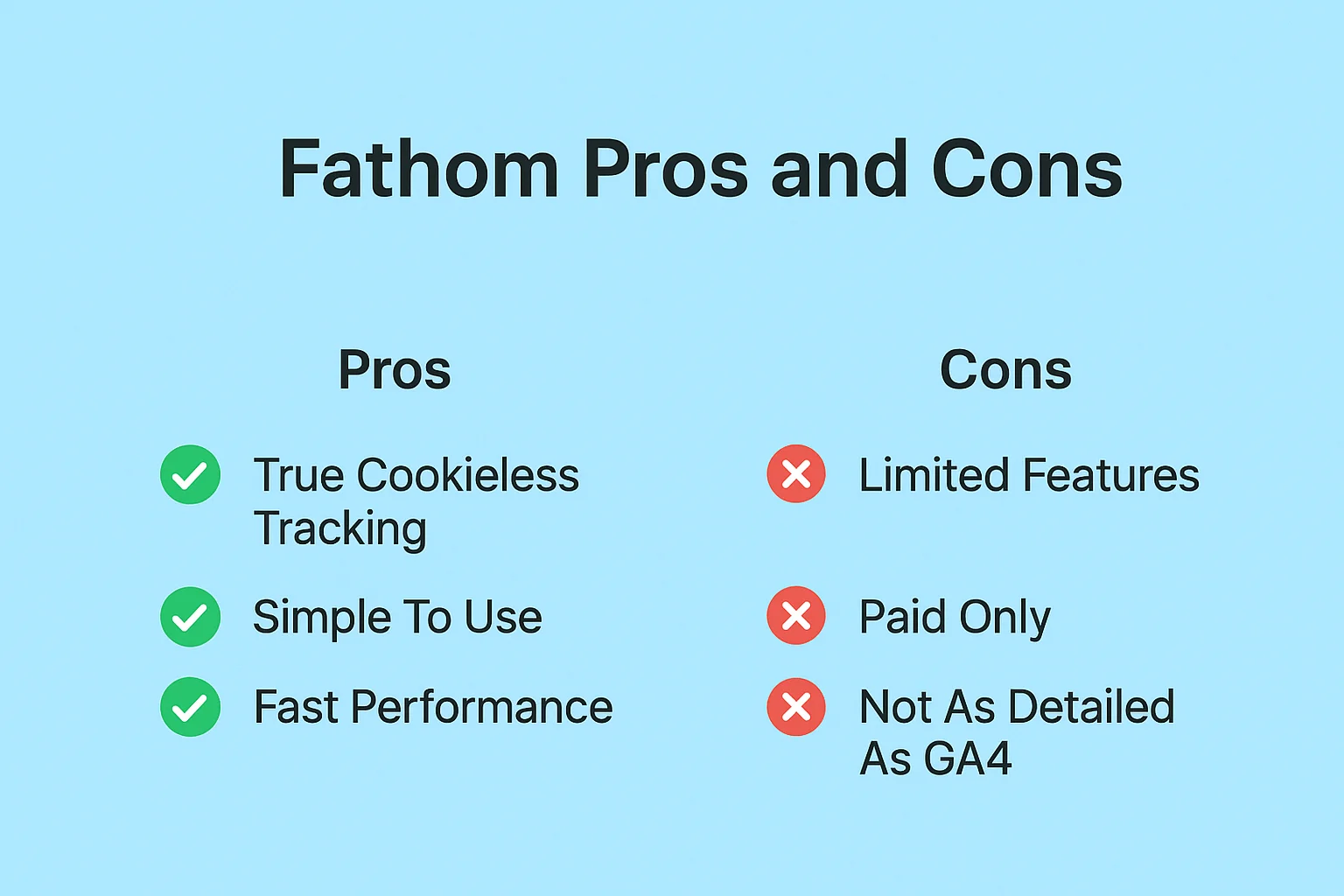
Key compliance cases: Fathom can often run without needing a consent banner, since it collects no personal data. This is a huge advantage for GDPR and ePrivacy compliance.
Ideal use cases: Great for bloggers, small businesses, and creators who want to avoid legal risks while still seeing basic traffic insights.
Common pitfalls: Some businesses switch to Fathom expecting the same level of detail as GA4, but they find its simplicity does not cover complex marketing needs.
Setting Up Analytics for WordPress: Key Compliance Steps
Analytics can help you understand what’s working on your site, but if you’re not careful, it can also create compliance risks. WordPress users must ensure their setup adheres to privacy regulations such as GDPR, CCPA, and ePrivacy.
The good news? With the right steps and tools, such as the WPLP Compliance Platform, you can gain insights that comply with laws like GDPR and CCPA.
Here’s a simple checklist to guide you:
1. Implement Analytics with Consent Banners
Most analytics tools rely on cookies, and that means user consent is required.
- With WPLP Compliance Platform, you can add customizable banners that automatically block analytics scripts until consent is given.
- Banners adapt to global privacy laws (GDPR, CCPA, etc.) and include links to your Privacy Policy.
- Users can adjust their preferences anytime, making the setup transparent and user-friendly.
2. Ensure Log Anonymization and DSAR Readiness
Users have the right to know what data you hold about them. Under GDPR and CCPA, this comes as Data Subject Access Requests (DSARs). To prepare:
- Enable IP anonymization in GA4, Matomo, or Fathom.
- Keep only the data you truly need (data minimization).
- Use WPLP to manage DSAR requests and respond quickly.
3. Use Geo-Targeting for Jurisdiction-Based Rules
Privacy requirements differ around the world.
- EU visitors need explicit opt-in consent, while in the US, opt-out may be enough.
- WPLP supports geo-targeted consent banners, showing the right message to the right audience.
- This prevents unnecessary friction while ensuring compliance in all regions.
4. Integrate Analytics with Privacy Policy and Consent Management
Your Privacy Policy should always explain how you use analytics.
- Be clear about what data is collected (IP address, browsing behavior, device type, etc.).
- Explain whether cookies are used and how long data is stored.
- Connect your analytics scripts to your consent manager, so tracking starts only after approval.
5. Regularly Audit and Update Settings
Compliance is not a one-time task it’s ongoing.
- Review consent banners and retention settings every few months.
- Stay updated with new privacy features in GA4, Matomo, or Fathom.
- Update your Privacy Policy whenever your tracking setup changes.
By following this checklist, you’ll create a WordPress analytics setup that’s compliant, transparent, and user-friendly. It not only helps you avoid fines but also builds trust with your audience, turning privacy into a strength, not a roadblock.
How WPLP Compliance Platform Enhances Analytics Privacy
Even if you pick the right analytics tool, staying compliant is not always easy. You still need consent banners, script controls, and a way to handle user requests. The WPLP Compliance Platform takes care of these steps for you, so your analytics runs smoothly and stays privacy-friendly.
1. Easy Consent Management
WPLP makes consent simple. It shows clear banners before analytics scripts load, so tools like GA4, Matomo, or Fathom only track when visitors agree. This means no data is collected without permission.
2. Auto-Blocking Unauthorized Scripts
Sometimes third-party tracking sneak in through themes or plugins. WPLP automatically blocks unauthorized scripts until consent is given. This keeps your site safe and prevents hidden tracking.
3. Proof of Consent and Logs
WPLP Compliance Platform keeps detailed logs of every consent choice, so you always have proof ready during audits or user complaints. This way, you can show the regulators that you’re running a privacy-first organisation.
4. DSAR-Ready Records
Under GDPR and CCPA, users can ask to see or delete their data. WPLP stores DSAR-ready records that make responding quick and easy. You won’t have to dig through databases to find the right information.
5. Works with WordPress Plugins
The platform is built to work smoothly with WordPress and integrates well with most popular plugins. In simple terms, this means you don’t have to worry about conflicts, errors, or broken features as the WPLP Compliance Platform runs alongside your existing tools without causing problems.
To summarise, WPLP Compliance Platform gives you all the tools you need to keep analytics safe, legal, and user-friendly. It handles the privacy side making your website fully compliant with the global privacy laws like GDPR, CCPA, ePrivacy Directive and more.
Which one should you choose?
GA4: Best for campaigns that are heavily reliant on ads with more advanced tracking capabilities and a deep dive into user behaviour. Just know that this is the least privacy-friendly option, and consent mechanisms may be necessary.
Matomo: Strikes the perfect balance between privacy compliance and advanced analytics features. Ideal for businesses that want actionable insights without compromising user trust.
Fathom: This was built for simplicity and privacy-first tracking. It is ideal for sites that want to set up a no-consent framework while still tracking the key metrics of the website in a timely manner.
Bottom Line: Your choice depends on your priorities, advanced marketing and ads (GA4), compliance with robust analytics (Matomo), or simplicity with privacy (Fathom).
FAQ
A privacy-friendly analytics platform is a tool that collects website data without violating user privacy laws like GDPR, CCPA, or ePrivacy.
These platforms focus on features like cookieless tracking, IP anonymization, limited data collection, and transparent consent options. Examples include Matomo (when self-hosted) and Fathom.
1. GA4: Yes. It uses cookies by default, so you need a consent banner for GDPR compliance.
2. Matomo: If you use cookies, then yes. But with Matomo’s cookieless tracking mode, consent may not be required.
3. Fathom: No. Fathom uses true cookieless tracking, so in most cases, you don’t need a cookie banner. But it’s advisable to get a banner from the WPLP Compliance Platform as it’s free.
Yes. Some tools, like Fathom and Matomo in cookieless mode, allow you to track visits without placing cookies on user devices. This means you can collect general insights (like page views or referrers) without needing user consent. However, if you combine analytics with other tools like ads or remarketing, you will still need consent banners.
The WPLP Compliance Platform makes analytics safe and legal on WordPress by:
1. Showing consent banners and blocking analytics scripts until users agree
2. Auto-blocking unauthorized trackers from themes or plugins
3. Storing proof of consent in logs for audits
4. Providing DSAR-ready records so you can respond to user requests fast
This saves time and lowers the risk of non-compliance.
Conclusion
Analytics is essential for growing any website, but it must be done in a way that respects privacy. The good news is that some tools help to give you insights as well as help in maintaining compliance with global privacy laws.
Tools like GA4, Matomo, and Fathom each offer different ways to track data. GA4 is powerful but complex, Matomo gives full control, and Fathom is simple and cookieless.
The right choice depends on your needs, but whatever you pick, you must set it up carefully. Consent banners, anonymisation, and clear privacy policies are not optional anymore.
This is where the WPLP Compliance Platform makes compliance easier. It helps you create a cookie consent banner and manage consent, blocks unwanted scripts, stores logs, and assists in responding to user requests.
Have you liked reading this article? Check out our other similar articles as well:
- How to Prepare Your WordPress Site for the End of Third-Party Cookies
- Avoid Dark Patterns Cookie Banners: Honest and Ethical Design for Compliance
- What is Data Processing? Types, and Compliance Requirements
Want to keep your analytics privacy-compliant on WordPress? Try the WPLP Compliance Platform.
